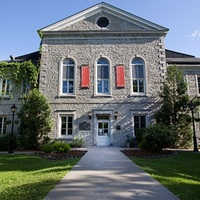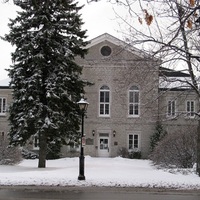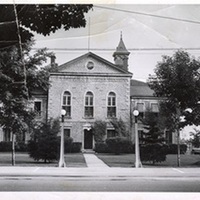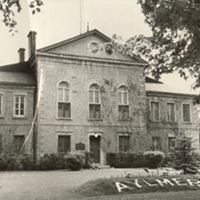LE PALAIS DE JUSTICE ET PRISON (1852) THE COURTHOUSE AND JAIL 120 rue Principale
Dublin Core
Title
LE PALAIS DE JUSTICE ET PRISON (1852) THE COURTHOUSE AND JAIL 120 rue Principale
Description
LE PALAIS DE JUSTICE ET PRISON (1852) 120 rue Principale
Cet impressionnant bâtiment en pierre a été construit en 1852 pour remplacer le palais de justice original de 1842, qui avait été détruit par un incendie. Desservant les comtés d'Ottawa et de Pontiac, le tribunal d'Aylmer était le premier du Bas-Canada à l'ouest de Montréal et il a assuré la proéminence d'Aylmer dans la région.
Ce centre judiciaire attire une communauté croissante de professionnels, dont des juges, des avocats, des notaires, des médecins et, avec eux, des commerçants, des artisans, des constructeurs et des ouvriers liés à l'industrie du bois en plein essor. La présence du palais de justice a joué un rôle fondamental dans le développement institutionnel de la région et de sa vie sociale. C'est ce qui explique aujourd'hui la concentration d'édifices institutionnels et résidentiels du XIXe siècle au cœur de la communauté et le long de la route d'Aylmer.
Lorsque le Canada est devenu une Confédération dotée de son propre gouvernement en 1867, le palais de justice d'Aylmer, propriété de la Couronne britannique, a été transféré au nouveau gouvernement et est spécifiquement mentionné dans l'Acte de l'Amérique du Nord britannique, ce qui souligne son importance juridique et symbolique.
Le palais de justice servait non seulement aux procès criminels - où les personnes accusées d'avoir enfreint la loi faisaient face à des juges et, dans certains cas, étaient emprisonnées - mais aussi aux litiges civils entre voisins, membres d'une même famille, marchands et propriétaires terriens. La prison, située à l'arrière du bâtiment, était surnommée « le trou » en raison de son obscurité et de son humidité.
Le tribunal a été déplacé à Hull en 1897 et le bâtiment est devenu l'hôtel de ville d'Aylmer. En 1900, l'ancienne prison a été convertie en caserne de pompiers, avec une haute tour où les pompiers suspendaient de longs tuyaux pour les faire sécher - une structure qui a été démolie en 1962 lors de travaux de rénovation. Lorsque le conseil municipal d'Aylmer a déménagé sur la place des Pionniers en 1987, l'édifice du palais de justice a servi de bibliothèque municipale.
Aujourd'hui, ce site historique abrite le Centre culturel du Vieux-Aylmer, qui poursuit sa mission publique dans un bâtiment riche en patrimoine civique et culturel.
THE COURTHOUSE AND JAIL (1852), 120 rue Principale
This impressive stone building was erected in 1852 to replace the original 1842 courthouse, which had been destroyed by fire. Serving the Counties of Ottawa and Pontiac the Court in Aylmer was the first in Lower Canada west of Montreal and it secured Aylmer’s prominence in the Region.
This judicial hub attracted a growing community of professionals, including judges, lawyers, notaries, doctors, and with them the tradesmen, craftsmen, builders and labourers linked to the booming lumber industry. The presence of the courthouse played a fundamental role in the institutional development of the region and its social life. It is the reason why, today, there is such a concentration of 19th century institutional and residential buildings in the heart of the community and along the Aylmer Road.
When Canada emerged as a Confederation with its own Government in1867, the Aylmer Court House, property of the British Crown, was transferred to the new government and is specifically mentioned in the British North America Act, underscoring its legal and symbolic importance.
The courthouse served not only criminal trials—where individuals accused of breaking the law faced judges and, in some cases, were jailed—but also civil disputes between neighbours, family members, merchants, and landowners. The jail, located at the back of the building, was known as “the hole” due to its dark and damp conditions.
The Court was moved to Hull in 1897 and the building became Aylmer’s Town Hall. In 1900, the former jail was converted into a fire station, complete with a tall tower where firefighters hung long hoses to dry - a structure later demolished in 1962 during renovations. When the Aylmer Council moved to Place des Pionniers in 1987, the Courthouse building served as Aylmer’s municipal library.
Today, this historic site is home to the Vieux-Aylmer Cultural Centre, continuing its public mission in a building rich with civic and cultural heritage.
Cet impressionnant bâtiment en pierre a été construit en 1852 pour remplacer le palais de justice original de 1842, qui avait été détruit par un incendie. Desservant les comtés d'Ottawa et de Pontiac, le tribunal d'Aylmer était le premier du Bas-Canada à l'ouest de Montréal et il a assuré la proéminence d'Aylmer dans la région.
Ce centre judiciaire attire une communauté croissante de professionnels, dont des juges, des avocats, des notaires, des médecins et, avec eux, des commerçants, des artisans, des constructeurs et des ouvriers liés à l'industrie du bois en plein essor. La présence du palais de justice a joué un rôle fondamental dans le développement institutionnel de la région et de sa vie sociale. C'est ce qui explique aujourd'hui la concentration d'édifices institutionnels et résidentiels du XIXe siècle au cœur de la communauté et le long de la route d'Aylmer.
Lorsque le Canada est devenu une Confédération dotée de son propre gouvernement en 1867, le palais de justice d'Aylmer, propriété de la Couronne britannique, a été transféré au nouveau gouvernement et est spécifiquement mentionné dans l'Acte de l'Amérique du Nord britannique, ce qui souligne son importance juridique et symbolique.
Le palais de justice servait non seulement aux procès criminels - où les personnes accusées d'avoir enfreint la loi faisaient face à des juges et, dans certains cas, étaient emprisonnées - mais aussi aux litiges civils entre voisins, membres d'une même famille, marchands et propriétaires terriens. La prison, située à l'arrière du bâtiment, était surnommée « le trou » en raison de son obscurité et de son humidité.
Le tribunal a été déplacé à Hull en 1897 et le bâtiment est devenu l'hôtel de ville d'Aylmer. En 1900, l'ancienne prison a été convertie en caserne de pompiers, avec une haute tour où les pompiers suspendaient de longs tuyaux pour les faire sécher - une structure qui a été démolie en 1962 lors de travaux de rénovation. Lorsque le conseil municipal d'Aylmer a déménagé sur la place des Pionniers en 1987, l'édifice du palais de justice a servi de bibliothèque municipale.
Aujourd'hui, ce site historique abrite le Centre culturel du Vieux-Aylmer, qui poursuit sa mission publique dans un bâtiment riche en patrimoine civique et culturel.
THE COURTHOUSE AND JAIL (1852), 120 rue Principale
This impressive stone building was erected in 1852 to replace the original 1842 courthouse, which had been destroyed by fire. Serving the Counties of Ottawa and Pontiac the Court in Aylmer was the first in Lower Canada west of Montreal and it secured Aylmer’s prominence in the Region.
This judicial hub attracted a growing community of professionals, including judges, lawyers, notaries, doctors, and with them the tradesmen, craftsmen, builders and labourers linked to the booming lumber industry. The presence of the courthouse played a fundamental role in the institutional development of the region and its social life. It is the reason why, today, there is such a concentration of 19th century institutional and residential buildings in the heart of the community and along the Aylmer Road.
When Canada emerged as a Confederation with its own Government in1867, the Aylmer Court House, property of the British Crown, was transferred to the new government and is specifically mentioned in the British North America Act, underscoring its legal and symbolic importance.
The courthouse served not only criminal trials—where individuals accused of breaking the law faced judges and, in some cases, were jailed—but also civil disputes between neighbours, family members, merchants, and landowners. The jail, located at the back of the building, was known as “the hole” due to its dark and damp conditions.
The Court was moved to Hull in 1897 and the building became Aylmer’s Town Hall. In 1900, the former jail was converted into a fire station, complete with a tall tower where firefighters hung long hoses to dry - a structure later demolished in 1962 during renovations. When the Aylmer Council moved to Place des Pionniers in 1987, the Courthouse building served as Aylmer’s municipal library.
Today, this historic site is home to the Vieux-Aylmer Cultural Centre, continuing its public mission in a building rich with civic and cultural heritage.
Source
Source: Enid Page, Archives APA-AHA mai, 2025
Citation
“LE PALAIS DE JUSTICE ET PRISON (1852) THE COURTHOUSE AND JAIL 120 rue Principale,” APA/AHA, accessed November 28, 2025, https://heritagediversity.com/apa/items/show/4170.





